Metabonomics Analysis of Stem Extracts from Dalbergia sissoo
Abstract
1. Introduction
- These data are helpful in determining and quantifying the types and concentrations of, and differences between, metabolites in two parts of the stem of Dalbergia sissoo.
- The distribution of these quantitative data can provide references for the metabonomics study of other species of Dalbergia.
- The correlation and database of metabolites of this species were obtained for metabonomics study in trees of medical importance.
- At present, the metabonomics of the Shisham has not been studied, so it is of great significance in the fields of biochemistry, biosynthesis, plant physiology, plant biotechnology, plant chemistry, and food chemistry.
2. Results
2.1. Analysis and Processing Results of Original Data
2.1.1. Total Ion Chromatographic Results
2.1.2. Identification Results of Metabolites
2.1.3. Correlation Analysis between Groups
2.2. Difference Analysis of Metabonomics between Heartwood and Sapwood
2.2.1. Principal Component Analysis (PCA)
2.2.2. Orthogonal Partial Least Squares Discriminant Analysis (OPLS-DA)
2.2.3. Determination and Classification of Differential Metabolites between the Two Groups
2.3. Analysis of Differential Metabolites
2.3.1. Differential Metabolite Classification and Pathway Analysis
2.3.2. Differences between Two Groups in Important Metabolic Pathways
2.3.3. Topological Analysis of Metabolic Pathways
3. Discussion
3.1. The Importance of Wood Extracts
3.2. Differential Metabolites of Heartwood and Sapwood
4. Materials and Methods
4.1. Experimental Materials
4.2. Sample Handling
- Accurately weigh 50 mg of sample into a 2 mL centrifuge tube and add a grinding bead with a diameter of 6 mm.
- Add 400 μL of extraction solution (methanol: Water = 4:1 (V:V), containing 0.02 mg/mL of internal standard (l–2-chlorophenylalanine).
- Grind for 6 min (−10 °C, 50 Hz) with a frozen tissue grinder.
- Carry out low-temperature ultrasonic extraction for 30 min (5 °C, 40 kHz).
- Leave the sample at −20 °C for 30 min.
- Centrifuge for 15 min (13,000× g, 4 °C), and transfer the supernatant to the injection vial with an internal cannula for UPLC-MS/MS analysis.
- In addition, take 20 μL of supernatant from each sample and mix it as the quality control sample (QC01, QC02, and QC03).
4.3. UPLC-MS/MS Conditions
4.4. Data Preprocessing and Annotation
4.5. Multivariate Statistical Analysis
5. Conclusions
Supplementary Materials
Author Contributions
Funding
Institutional Review Board Statement
Informed Consent Statement
Data Availability Statement
Acknowledgments
Conflicts of Interest
Sample Availability
References
- Sultana, S.; Asif, H.M.; Naveed Akhtar, N.; Akhtar, N. Dalbergia sissoo Roxb: Monograph. Int. J. Pharmacogn. 2015, 2, 440–443. [Google Scholar]
- Pande, P.K.; Singh, M. Inter-clonal, intra-clonal, and single tree variations of wood anatomical properties and specific gravity of clonal ramets of Dalbergia sissoo Roxb. Wood Sci. Technol. 2005, 39, 351–366. [Google Scholar] [CrossRef]
- Ahmad, I.; Atiq, M.; Nawaz, M.F.; Ahmed, S.; Asif, M.; Gull, S. Prediction of dieback disease of Dalbergia Sissoo (shisham) based upon environmental factors and tree age. Appl. Ecol. Environ. Res. 2019, 17, 6483–6495. [Google Scholar] [CrossRef]
- Shi, L.; Sun, Q.F.; Deng, J. Primary Study on the Wood Anatomical and Physical-Mechanical Properties of Introduced Dalbergia sissoo. Adv. Mater. Res. 2011, 179–180, 1446–1452. [Google Scholar] [CrossRef]
- Munir, H.; Shahid, M.; Anjum, F. Structural, thermal and rheological characterization of modified Dalbergia sissoo gum—A medicinal gum. Int. J. Biol. Macromol. 2016, 84, 236–245. [Google Scholar] [CrossRef]
- Ijaz, S.; Haq, I.U. Dalbergia Sissoo: Biology, Ecology and Sustainable Agroforestry; Library of Congress Cataloging-in-Publication Data; CRC Press: Boca Raton, FL, USA, 2022. [Google Scholar]
- Mannan, M.; Abdul, K.; Ambia, K.; Farhad, H. Antinociceptive effect of methanol extract of Dalbergia sissoo leaves in mice. BMC Complement. Altern. Med. 2017, 17, 72. [Google Scholar] [CrossRef]
- Shah, M.H.; Mukhtar, I.; Khan, S.N. Medical importance and association of pathological constraints with Dalbergia sissoo. Pak. J. Phytopathol. 2010, 22, 135–138. [Google Scholar]
- Government of India, Department of AYUSH. Ayurvedic Pharmacopoeia of India, Part I, Volume III; Ministry of Health and Welfare: Ghaziabad, India, 1999. [Google Scholar]
- Liu, L.; Liu, Y.; Yin, J.; Gen, Y.; Li, B.; Han, H.; Zhao, P. Comparative metabolomics analysis on heartwood and sapwood components of teak (Tectona grandis). J. For. Eng. 2021, 6, 100–106. [Google Scholar]
- Hillis, W.E. The Formation of Heartwood and Its Extractives. In Phytochemicals in Human Health Protection, Nutrition and Plant Defense; Romeo, J.T., Ed.; Recent Advances in Phytochemistry (Proceedings of the Phytochemical Society of North America); Springer: Boston, MA, USA, 1999; Volume 33. [Google Scholar]
- Nakaba, S.; Yamagishi, Y.; Sano, Y. Temporally and spatially controlled death of parenchyma cells is involved in heartwood formation in pith regions of branches of Robinia pseudoacacia var inermis. J. Wood Sci. 2012, 58, 69–76. [Google Scholar] [CrossRef]
- Taylor, A.; Cooper, P. The effect of stem girdling on wood quality. Wood Fiber Sci. J. Soc. Wood Sci. Technol. 2002, 34, 212–220. [Google Scholar]
- Cui, Z.; Li, X.; Xu, D.; Yang, Z. Changes in Non-Structural Carbohydrates, Wood Properties and Essential Oil During Chemically-Induced Heartwood Formation in Dalbergia odorifera. Front. Plant Sci. 2020, 11, 1161. [Google Scholar] [CrossRef] [PubMed]
- Bergström, B. Chemical and structural changes during heartwood formation in Pinus sylvestris. Forestry 2003, 76, 45–53. [Google Scholar] [CrossRef]
- Piqueras, S.; Füchtner, S.; Rocha de Oliveira, R.; Gómez-Sánchez, A.; Jelavić, S.; Keplinger, T.; de Juan, A.; Thygesen, L.G. Understanding the Formation of Heartwood in Larch Using Synchrotron Infrared Imaging Combined with Multivariate Analysis and Atomic Force Microscope Infrared Spectroscopy. Front. Plant Sci. 2020, 10, 1701. [Google Scholar] [CrossRef] [PubMed]
- Miranda, I.; Sousa, V.; Ferreira, J.; Pereira, H. Chemical characterization and extractives composition of heartwood and sapwood from Quercus faginea. PLoS ONE 2017, 12, e0179268. [Google Scholar] [CrossRef]
- Spicer, R. Senescence in Secondary Xylem: Heartwood Formation as an Active Developmental Program. In Vascular Transport in Plants; Holbrook, N.M., Zwieniecki, M.A., Eds.; Elsevier Academic: Amsterdam, The Netherlands, 2005; pp. 126–143. [Google Scholar] [CrossRef]
- Magel, E. Biochemistry and Physiology of Heartwood Formation. In Cell and Molecular Biology of Wood Formation; Savidge, R., Barnett, J., Napier, R., Eds.; BIOS Scientific Publishers: Oxford, UK, 2000; pp. 64–90. [Google Scholar]
- Kampe, A.; Magel, E. New Insights into Heartwood and Heartwood Formation. In Cellular Aspects of Wood Formation; Fromm, J., Ed.; Plant Cell Monographs; Springer: Berlin/Heidelberg, Germany, 2013; Volume 20, pp. 11–26. [Google Scholar]
- Spicer, R. Variation in Angiosperm Wood Structure and Its Physiological and Evolutionary Significance. In Comparative and Evolutionary Genomics of Angiosperm Trees; Groover, A., Cronk, Q., Eds.; Plant Genetics and Genomics: Crops and Models; Springer: Cham, Switzerland, 2016; Volume 21, pp. 19–60. [Google Scholar]
- Dünisch, O.; Richter, H.G.; Koch, G. Wood properties of juvenile and mature heartwood in Robinia pseudoacacia L. Wood Sci. Technol. 2010, 44, 301–313. [Google Scholar] [CrossRef]
- Bush, D.; McCarthy, K.; Meder, R. Genetic variation of natural durability traits in Eucalyptus cladocalyx (sugar gum). Ann. For. Sci. 2011, 68, 1057–1066. [Google Scholar] [CrossRef]
- Kwon, M.; Davin, L.B.; Lewis, N.G. In situ hybridization and immunolocalization of lignan reductases in woody tissues: Implications for heartwood formation and other forms of vascular tissue preservation. Phytochemistry 2001, 57, 899–914. [Google Scholar] [CrossRef]
- Seo, C.-S.; Shin, H.-K. Simultaneous Analysis for Quality Control of Traditional Herbal Medicine, Gungha-Tang, Using Liquid Chromatography–Tandem Mass Spectrometry. Molecules 2022, 27, 1223. [Google Scholar] [CrossRef]
- Casas-Ferreira, A.M.; Nogal-Sánchez, M.D.; Pérez-Pavón, J.L.; Moreno-Cordero, B. Non-separative mass spectrometry methods for non-invasive medical diagnostics based on volatile organic compounds: A review. Anal. Chim. Acta 2019, 1045, 10–22. [Google Scholar] [CrossRef]
- Rao, G.; Liu, X.; Zha, W.; Wu, W.; Zhang, J. Metabolomics reveals variation and correlation among different tissues of olive (Olea europaea L.). Biol. Open 2017, 6, 1317–1323. [Google Scholar] [CrossRef]
- Qiu, H.; Zhu, X.; Wan, H. Parallel Metabolomic and Transcriptomic Analysis Reveals Key Factors for Quality Improvement of Tea Plants. J. Agric. Food Chem. 2020, 68, 5483–5495. [Google Scholar] [CrossRef] [PubMed]
- Shen, X.; Lu, W.; Chen, Y. Aluminum stress on root metabolism of peanut based on metabolomics of UPLC-MS/MS. Chin. J. Oil Crop Sci. 2022, in press. [Google Scholar] [CrossRef]
- Yang, G.; Liang, K.; Zhou, Z.; Wang, X.; Huang, G. UPLC-ESI-MSMS-Based Widely Targeted Metabolomics Analysis of Wood Metabolites in Teak (Tectona grandis). Molecules 2020, 25, 2189. [Google Scholar] [CrossRef] [PubMed]
- Ravaomanalina, B.H.; Crivellaro, A.; Schweingruber, F.H. Stem Anatomy of Dalbergia and Diospyros Species from Madagascar; Springer International Publishing: Berlin, Germany, 2017; pp. 112–137. [Google Scholar]
- Tiina, B.; Martti, V.; Michael, A.; Anni, H.; Lauri, R. Extractive concentrations and cellular-level distributions change radially from outer to inner heartwood in Scots pine. Tree Physiol. 2021, 41, 1034–1045. [Google Scholar] [CrossRef]
- Johansson, C.I.; Saddler, J.N.; Beatson, R.P. Characterization of the polyphenolics related to the colour of western red cedar (Thuja plicata Donn) heartwood. Holzforschung 2000, 54, 246–254. [Google Scholar] [CrossRef]
- Kumar, P.; Kushwaha, P.; Khedgikar, V. Neoflavonoids as potential osteogenic agents from Dalbergia sissoo heartwood. Pergamon 2014, 24, 2664–2668. [Google Scholar] [CrossRef]
- Khan, M.I.; Khan, M.R. Gastroprotective Potential of Dalbergia sissoo Roxb. Stem Bark against Diclofenac-Induced Gastric Damage in Rats. Osong Public Health Res. Perspect. 2013, 4, 271–277. [Google Scholar] [CrossRef][Green Version]
- Anirudha, K.; Vikram, K.; Priyanka, K. Heartwood extract from Dalbergia sissoo promotes fracture healing and its application in ovariectomy-induced osteoporotic rats. J. Pharm. Pharmacol. 2017, 69, 1381–1397. [Google Scholar]
- Khedgikar, V.; Kushwaha, P.; Ahmad, N. Ethanolic extract of Dalbergia sissoo promotes rapid regeneration of cortical bone in drill-hole defect model of rat. Biomed. Pharmacother. 2017, 86, 16–22. [Google Scholar] [CrossRef]
- Kharkwal, H.; Joshi, D.D.; Kharkwal, A.; Panthari, P. Anti-termite activity of heartwood of Dalbergia sissoo Roxb. Ex. Dc. Asian Pac. J. Biomed. 2012, 2, 1–4. [Google Scholar]
- Zhang, B.; Cai, J.; Duan, C.Q.; Reeves, M.J.; He, F. A review of polyphenolics in oak woods. Int. J. Mol. Sci. 2015, 16, 6978–7014. [Google Scholar] [CrossRef] [PubMed]
- Vyas, P.; Yadav, D.K.; Khandelwal, P. Tectona grandis (teak)—A review on its phytochemical and therapeutic potential. Nat. Prod. Res. 2019, 33, 2338–2354. [Google Scholar] [CrossRef] [PubMed]
- Shukla, R.; Sharma, D.C.; Baig, M.H. Antioxidant, antimicrobial activity and medicinal properties of Grewia asiatiea L. Med. Chem. 2015, 10, 76. [Google Scholar]
- Roy, N.; Laskar, R.A.; Sk, I.; Kumari, D.; Ghosh, T.; Begum, N.A. A detailed study on the antioxidant activity of the stem bark of Dalbergia sissoo Roxb., an Indian medicinal plant. Food Chem. 2011, 126, 1115–1121. [Google Scholar] [CrossRef]
- Niamke, B.F.; Adima, A.A.; Seraphin, K.C.; Amusant, N.; Jay-Allemand, C. Heartwood formation process in teak (Tectona grandis L. f): Fate of non-structural carbohydrates and characterization of forsythoside B. Int. J. Biol. Chem. Sci. 2018, 12, 1102–1112. [Google Scholar] [CrossRef][Green Version]
- Lehnebach, R.; Morel, H.; Bossu, J.; Le Moguédec, G.; Amusant, N.; Beauchêne, J.; Nicolini, E. Heartwood/sapwood profile and the tradeoff between trunk and crown increment in a natural forest: The case study of a tropical tree (Dicorynia guianensis Amsh., Fabaceae). Trees 2017, 31, 199–214. [Google Scholar] [CrossRef]
- Nagai, S.; Utsumi, Y. The function of intercellular spaces along the ray parenchyma in sapwood, intermediate wood, and heartwood of Cryptomeria japonica (Cupressaceae). Am. J. Bot. 2012, 99, 1553–1561. [Google Scholar] [CrossRef]
- Saito, K.; Mitsutani, T.; Imai, T.; Matsushita, Y.; Yamamoto, A.; Fukushima, K. Chemical differences between sapwood and heartwood of Chamaecyparis obtusa detected by ToF-SIMS. Appl. Surf. Sci. 2008, 255, 1088–1091. [Google Scholar] [CrossRef]
- Song, K.; Liu, B.; Jiang, X.; Yin, Y. Cellular changes of tracheids and ray parenchyma cells from cambium to heartwood in Cunninghamia lanceolata. J. Trop. For. Sci. 2011, 23, 478–487. [Google Scholar]
- Nakaba, S.; Kubo, T.; Funada, R. Differences in patterns of cell death between ray parenchyma cells and ray tracheids in the conifers Pinus densiflora and Pinus rigida. Trees 2008, 22, 623–630. [Google Scholar] [CrossRef]
- Scully, E.D.; Gries, T.; Sarath, G. Over expression of SbMyb60 Impacts Phenylpropanoid Biosynthesis and Alters Secondary Cell Wall Composition in Sorghum bicolor. Plant J. 2015, 85, 378–395. [Google Scholar] [CrossRef] [PubMed]
- Dixon, R.A.; Pasinetti, G.M. Flavonoids and isoflavonoids: From plant biology to agriculture and neuroscience. Plant Physiol. 2010, 154, 453–457. [Google Scholar] [CrossRef] [PubMed]
- Dias, M.C.; Pinto, D.C.G.A.; Silva, A.M.S. Plant Flavonoids: Chemical Characteristics and Biological Activity. Molecules 2021, 26, 5377. [Google Scholar] [CrossRef]
- Bennett, A.A.; Mahood, E.H.; Fan, K.; Moghe, G.D. Untargeted metabolomics of purple and orange-fleshed sweet potatoes reveals a large structural diversity of anthocyanins and flavonoids. Sci. Rep. 2021, 11, 16408. [Google Scholar] [CrossRef] [PubMed]
- Yang, S.H.; Liu, Y.; Wang, Q.; Sun, Y.P.; Guan, W.; Liu, Y.; Yang, B.Y.; Kuang, H.X. UPLC-MS/MS Identification and Quantification of Withanolides from Six Parts of the Medicinal Plant Datura Metel L. Molecules 2020, 25, 1260. [Google Scholar] [CrossRef] [PubMed]
- Xia, X.; Chen, C.; Yang, L.; Wang, Y.; Duan, A.; Wang, D. Analysis of metabolites in young and mature Docynia delavayi (Franch.) Schneid leaves using UPLC-ESI-MS/MS. PeerJ 2022, 10, e12844. [Google Scholar] [CrossRef]
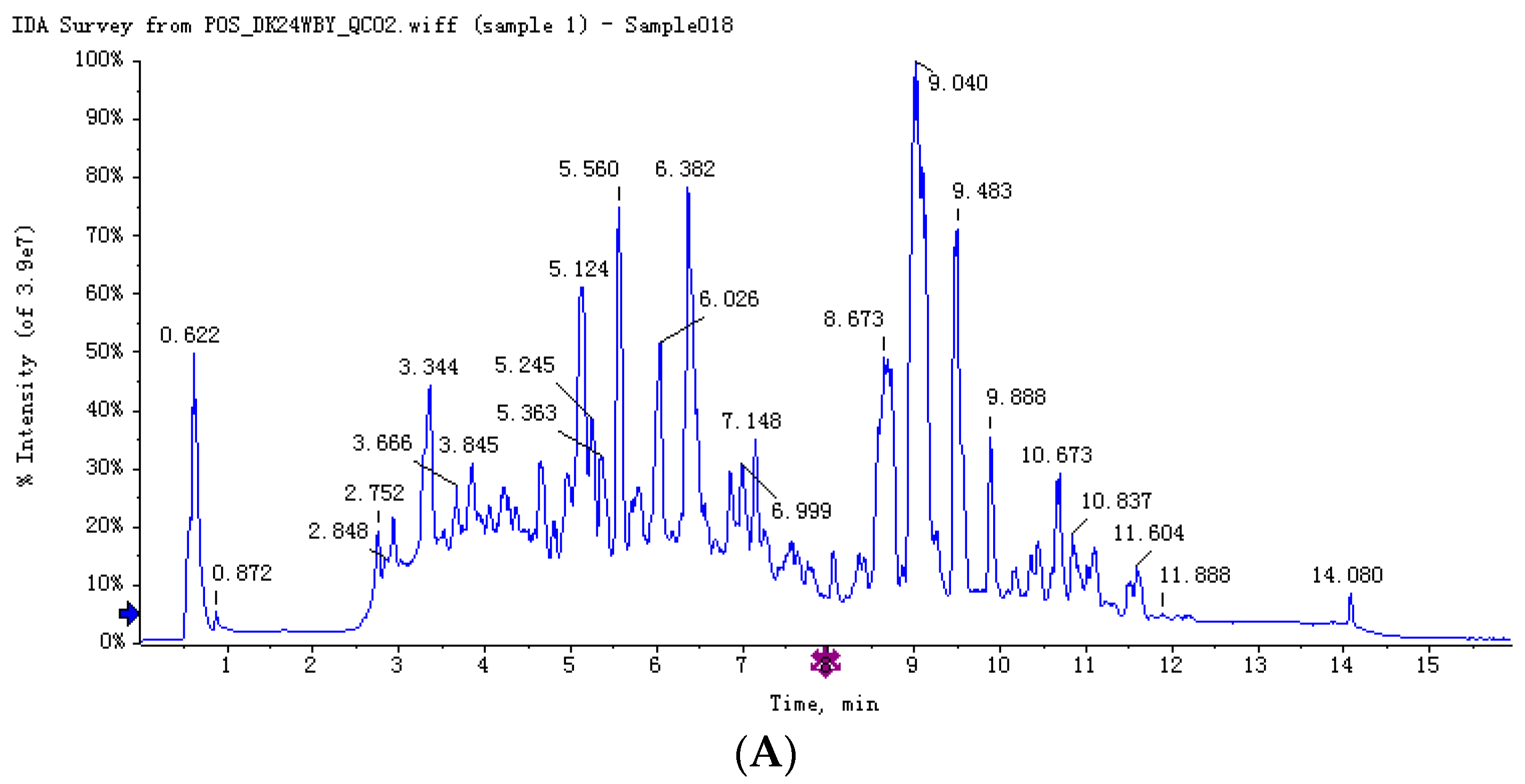

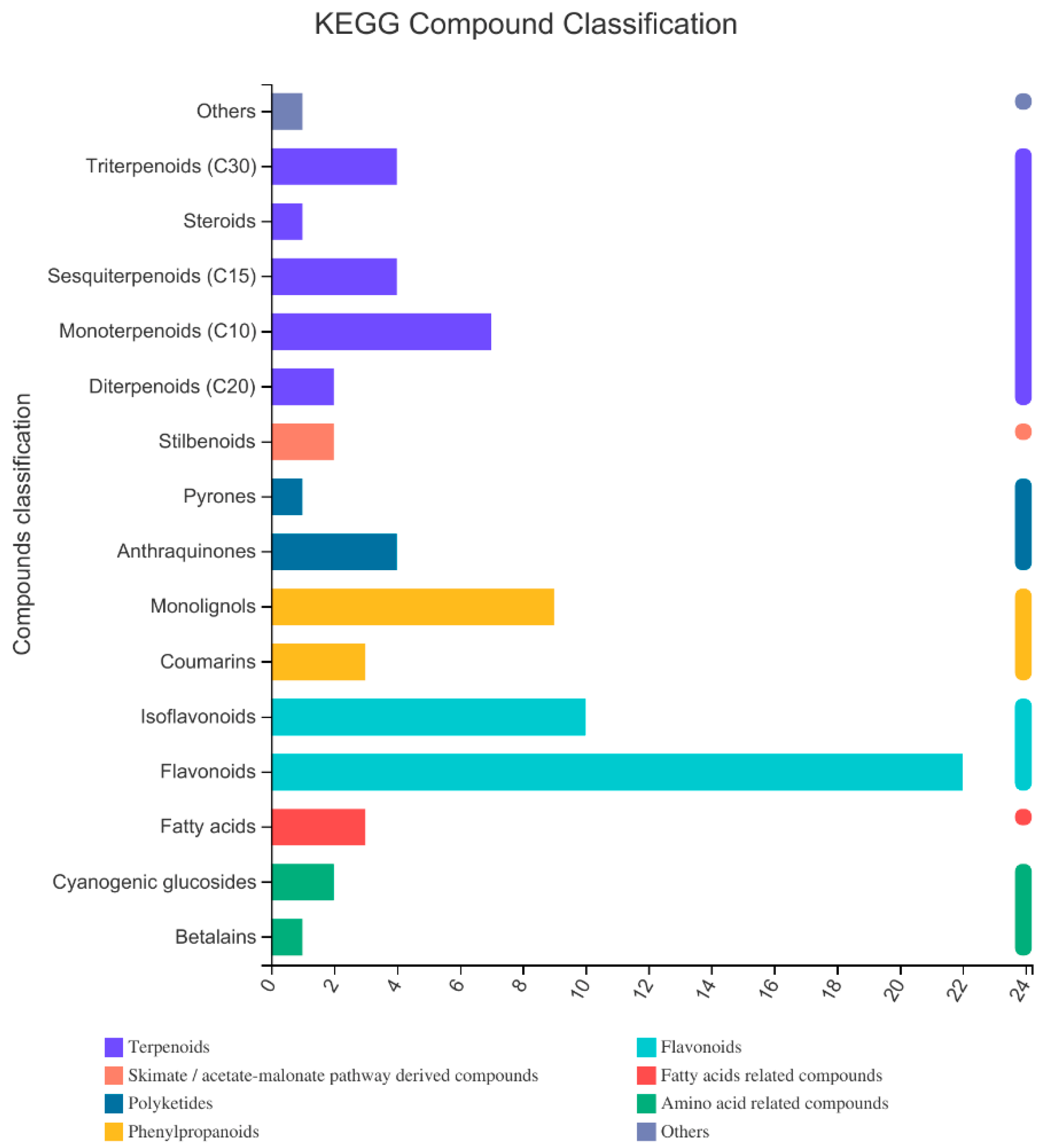
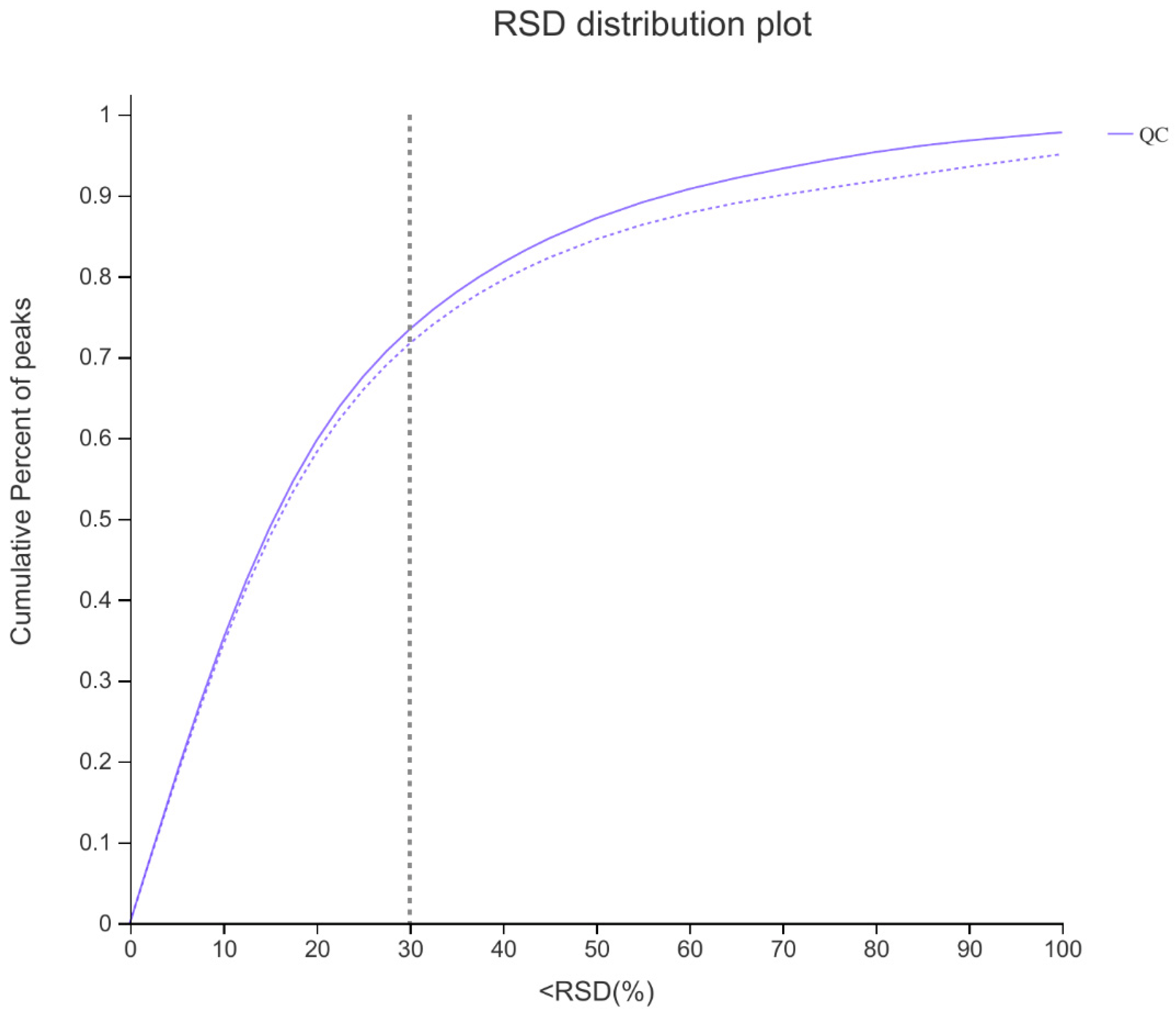
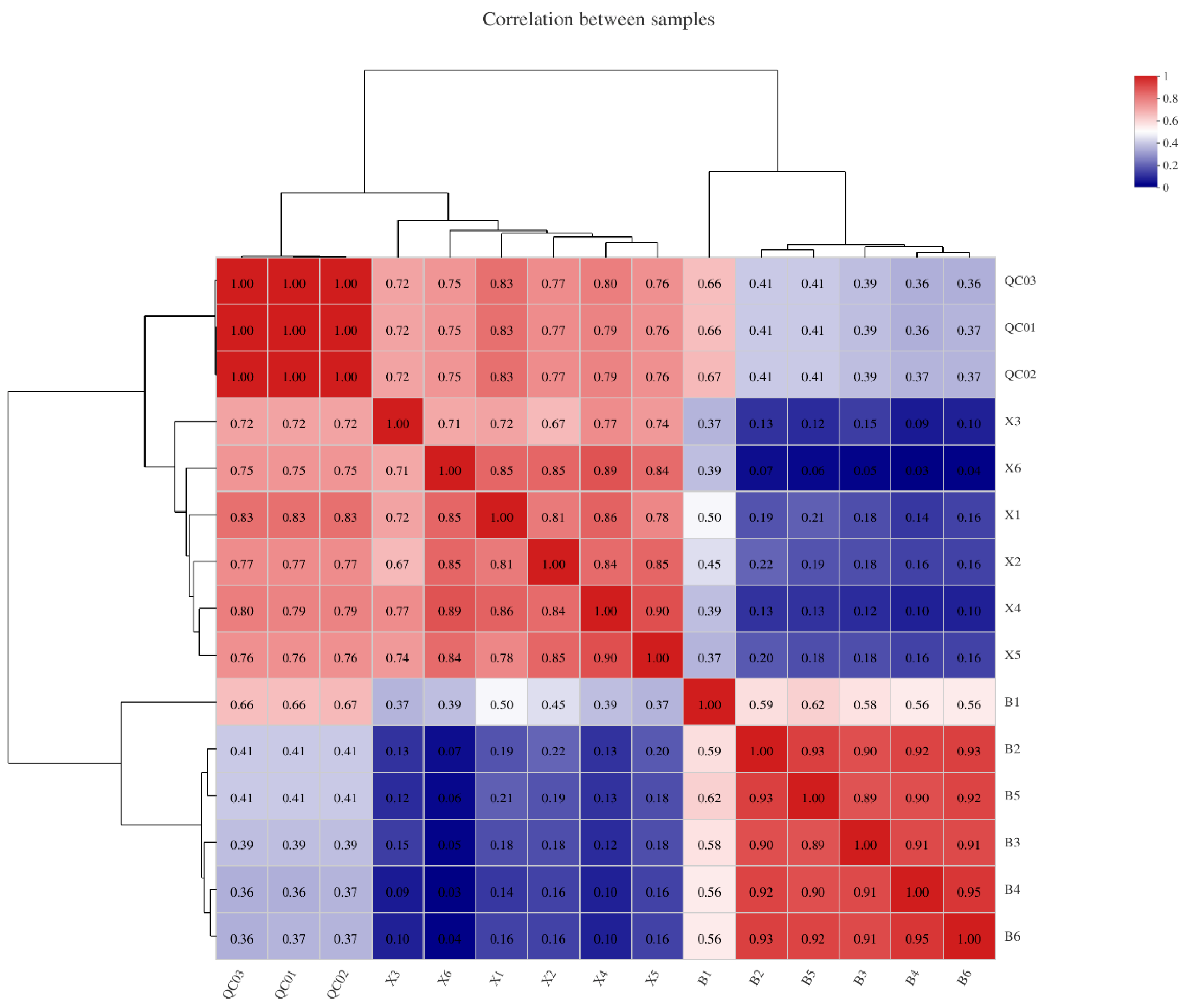


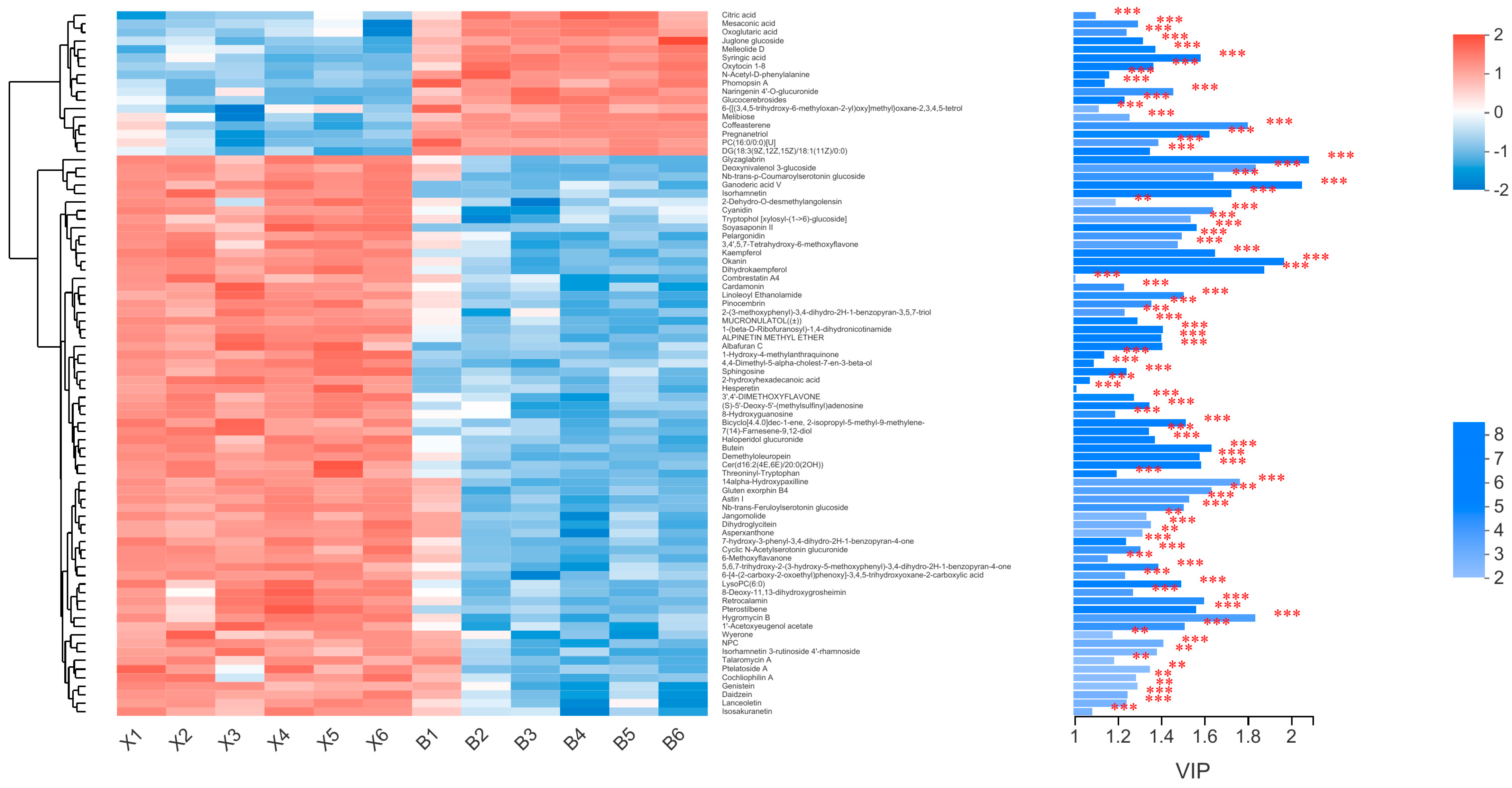
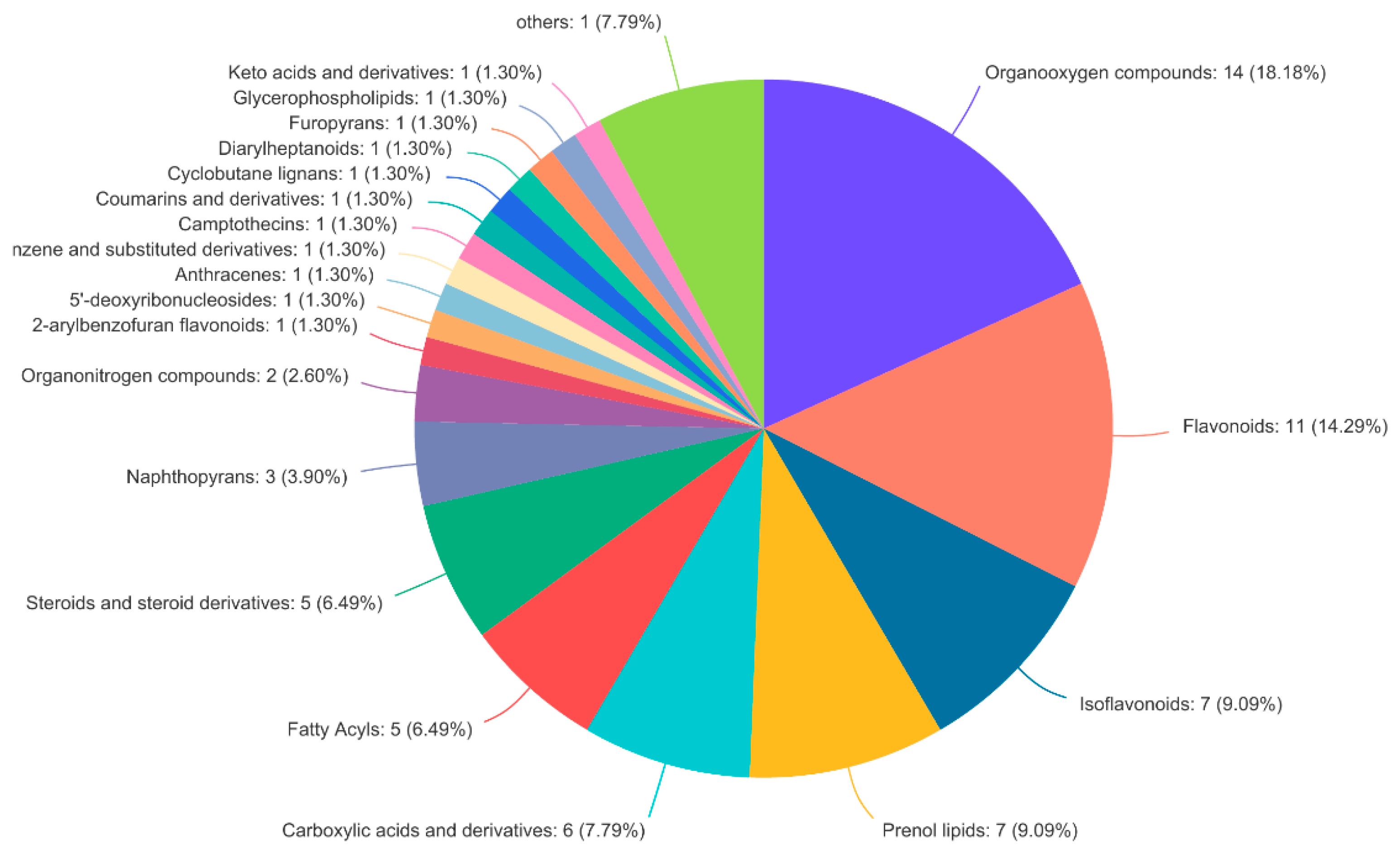
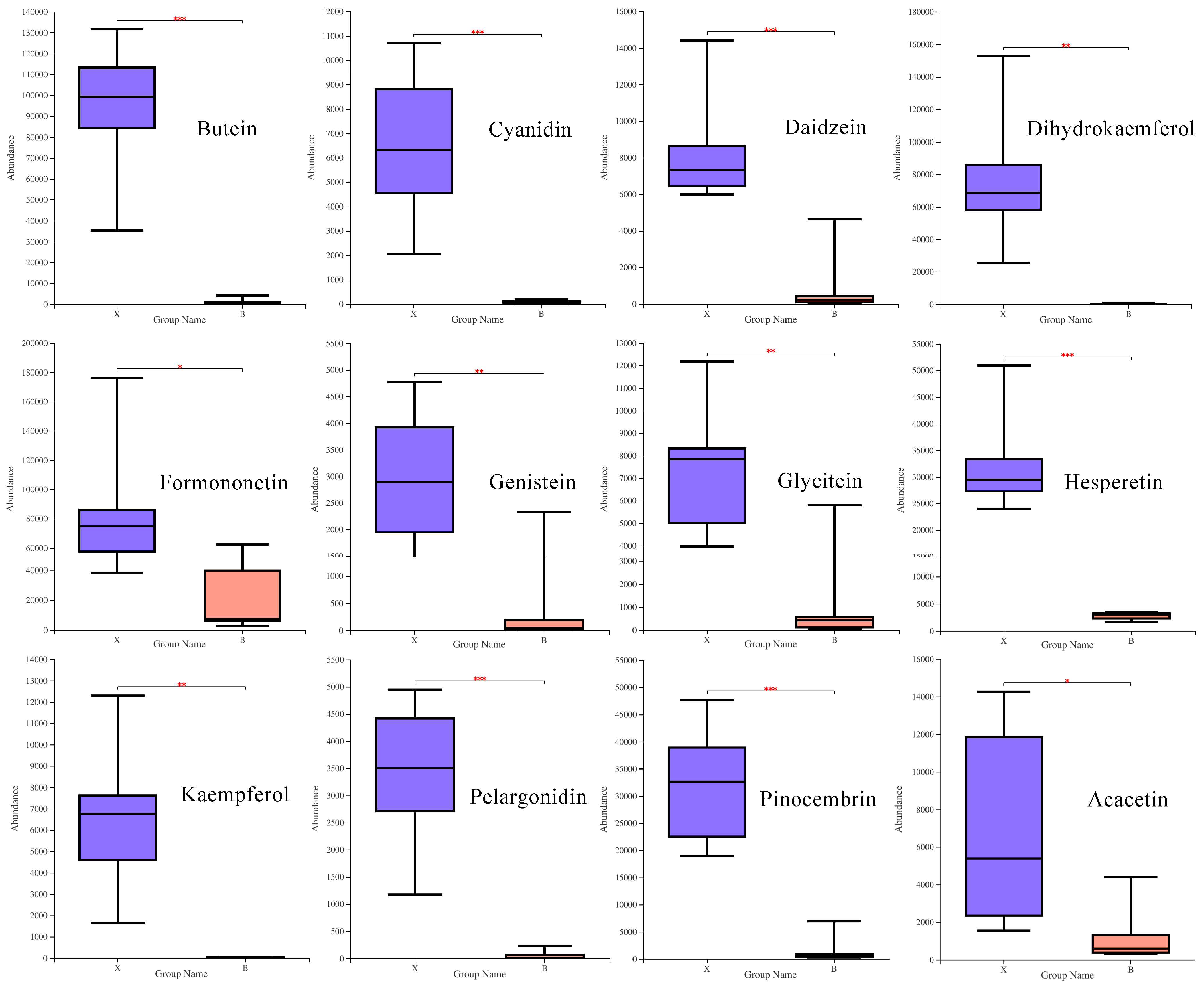
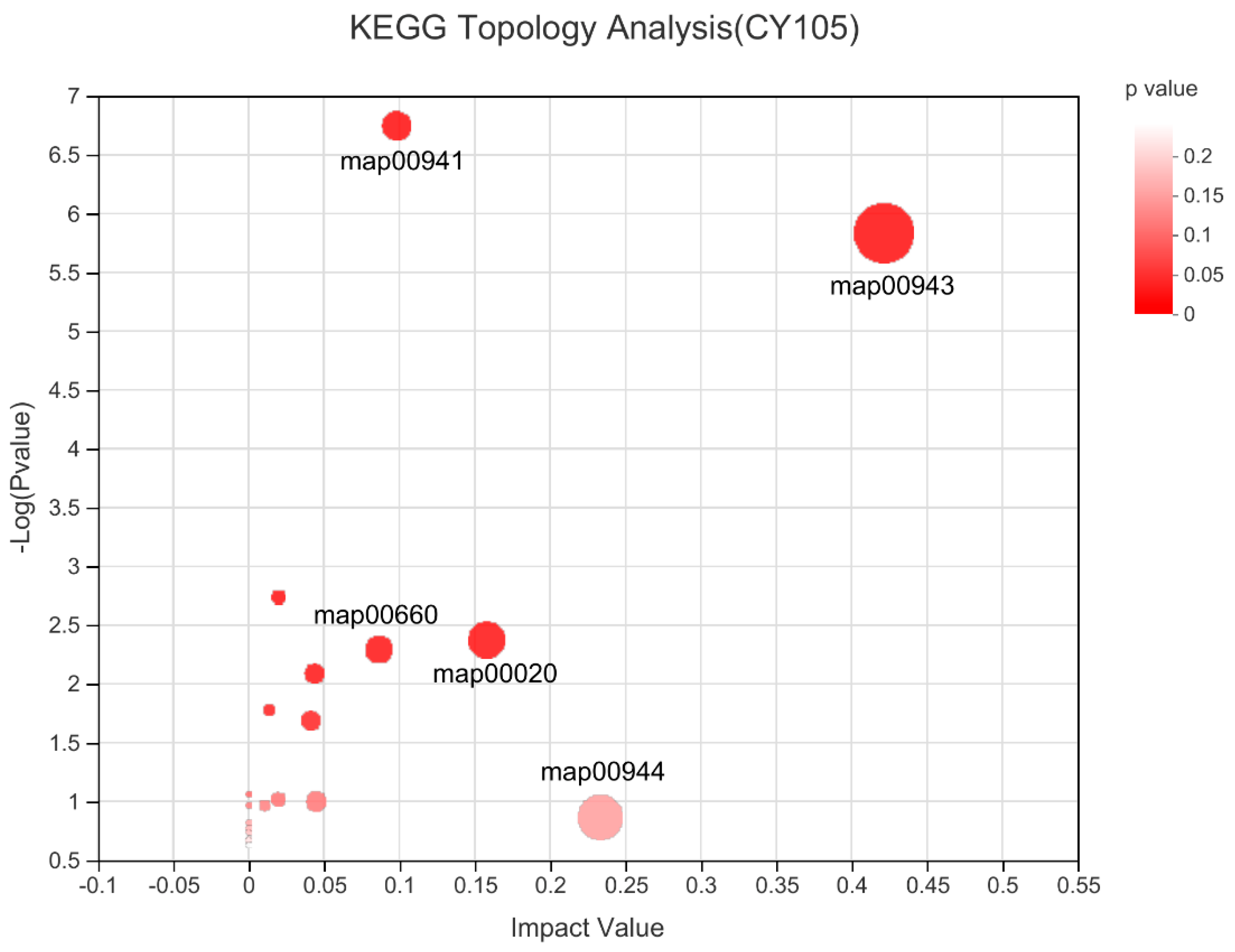
| Ion Mode | All Peaks | Identified Metabolites | Metabolites in Library | Metabolites in KEGG |
|---|---|---|---|---|
| pos | 5704 | 346 | 311 | 94 |
| neg | 4894 | 389 | 365 | 88 |
| Pathway ID | Description | Number | Metabolites | Retention Time | Class |
|---|---|---|---|---|---|
| map00941 | Flavonoid biosynthesis | 7 | Butein | 3.833 | Chalcones |
| Pinocembrin | 5.7929 | Flavanones | |||
| Hesperetin | 4.5791 | Flavanones | |||
| Dihydrokaempferol | 4.1904 | Dihyroflavonols | |||
| Kaempferol | 3.554 | Flavonols | |||
| Pelargonidin | 3.87 | Anthocyanidins and anthocyanins | |||
| Cyanidin | 3.5594 | Anthocyanidins and anthocyanins | |||
| map00943 | Isoflavonoid biosynthesis | 4 | Daidzein | 4.2676 | Isoflavones |
| Formononetin | 5.2318 | Isoflavones | |||
| Glycitein | 4.1901 | Isoflavones | |||
| Genistein | 4.2578 | Isoflavones | |||
| map00944 | Flavone and flavonol biosynthesis | 2 | Kaempferol | 3.554 | Flavonols |
| Acacetin | 4.3609 | Flavones |
| Time (min) | A (%) | B (%) |
|---|---|---|
| 0 | 95 | 5 |
| 3 | 80 | 20 |
| 9 | 5 | 95 |
| 13 | 5 | 95 |
| 13.1 | 95 | 5 |
| 16 | 95 | 5 |
Publisher’s Note: MDPI stays neutral with regard to jurisdictional claims in published maps and institutional affiliations. |
© 2022 by the authors. Licensee MDPI, Basel, Switzerland. This article is an open access article distributed under the terms and conditions of the Creative Commons Attribution (CC BY) license (https://creativecommons.org/licenses/by/4.0/).
Share and Cite
Li, M.; Liu, M.; Wang, B.; Shi, L. Metabonomics Analysis of Stem Extracts from Dalbergia sissoo. Molecules 2022, 27, 1982. https://doi.org/10.3390/molecules27061982
Li M, Liu M, Wang B, Shi L. Metabonomics Analysis of Stem Extracts from Dalbergia sissoo. Molecules. 2022; 27(6):1982. https://doi.org/10.3390/molecules27061982
Chicago/Turabian StyleLi, Mengxue, Mengying Liu, Bingyi Wang, and Lei Shi. 2022. "Metabonomics Analysis of Stem Extracts from Dalbergia sissoo" Molecules 27, no. 6: 1982. https://doi.org/10.3390/molecules27061982
APA StyleLi, M., Liu, M., Wang, B., & Shi, L. (2022). Metabonomics Analysis of Stem Extracts from Dalbergia sissoo. Molecules, 27(6), 1982. https://doi.org/10.3390/molecules27061982






